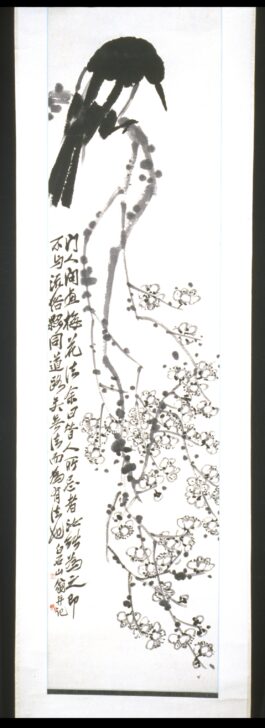Plum Blossoms and Bird
Qi Baishi

Description
Qi Baishi, born into a poor peasant family, taught himself to paint by studying the Mustard Seed Garden Manual of Painting, an illustrated treatise on Chinese painting composed in
the early Qing (1644–1912) dynasty. In his late twenties his work was discovered by a patron who supported his formal education in painting and literature. This allowed Qi to travel widely throughout China, studying the work of the great seventeenth-century individualist painters Shitao (1621–circa 1720) and Bada Shanren (1625–after 1705). These artists valued innovation over imitation and used free brushwork to explore the expressive potential of painting. Qi’s mature style is a deeply personal assimilation of their styles into his own folk art roots.
The subject of plum blossoms was a favorite among scholar- painters. Because they bloom in the very late winter, plum blossoms are likened to the scholar who thrives in adverse environments. Plum blossoms also offered the formal beauty of the contrast between the angular branches and
the delicate, rounded blossoms.
Subject Matter:
The subject of plum blossoms had long been a favorite among scholar-painters. Because they bloom in the very late winter, plum blossoms are likened to the scholar who thrives in adverse environments. Plum blossoms also offered the sheer formal beauty of contrast between the thrusting, angular branches and the delicate, rounded blossoms.
Physical Description:
A black crow is seated on a plum branch above calligraphic text and cascades of open blossoms.
Usage Rights:
If you are interested in using an image for a publication, please visit https://umma.umich.edu/request-image/ for more information and to fill out the online Image Rights and Reproductions Request Form.